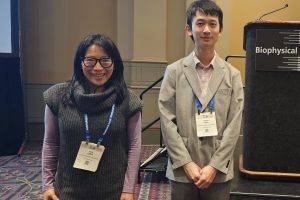
Junjie Chen, fifth-year PhD student of mechanical engineering, presented his research project, “Controlling Cell Behavior with Engineered Magnetosensitive Proteins,” at the Biophysical Society Annual Meeting, held Feb. 10-14 in Philadelphia. Chen was selected for the podium presentation out of thousands of submissions to talk about his innovative approaches to studying quantum mechanical effects.
“Our work got a lot of attention!” said Chen, who also chaired the Bioengineering Platform at the conference. “I exchanged notes with scientists around the world who are very excited about our vision of controlling cells with light and magnetic field. What we are studying is a small niche at the intersection of cell biology, quantum physics, and engineering, but the field surely seems to be picking up momentum.”
Junjie Chen is advised by Yun Chen, assistant professor of mechanical engineering, associate researcher at the Institute for NanoBioTechnology, and member of the Center for Cell Dynamics.
“Junjie is a talented experimentalist and insightful thinker, but most importantly he works very hard,” the advisor said. “He never becomes fazed even at the most challenging moment, he just pushes forward. He deserves the recognition.”
Yun Chen explained that the research team now can apply magnetic fields and light of different power to make cells behave differently. For example, cells will degrade proteins more if they project a strong magnetic field to the cell samples. The principle behind this technology is similar to the kind implemented in quantum computers.
“Usually we control cells with chemicals, such as drugs or growth factors, and cells start to react to the chemical triggers,” she said. “We think that using our technology, one day we can make cells do whatever we’d like them to do with magnetic fields, perhaps even more than what chemicals can accomplish.”
PRESENTATION ABSTRACT
Title: Controlling Cell Behavior with Engineered Magnetosensitive Proteins
Cryptochromes (CRY) are a family of naturally occurring magnetosensitive proteins. The magnetosensitivity of CRY arises from the FAD bound within forming a spin-correlated radical pair (RP) with the tryptophan residues on the protein body. When no magnetic field is present, the spin state of the RP is constantly oscillating between singlet and triplet states. Weak magnetic fields (~mT) change the energy of the states through Zeeman splitting, inhibiting the mixing of spin states. Thus, magnetic fields can alter the relative yield of reaction products unique to singlet or triplet states. We took advantage of this magnetosensitivity in CRY2, a protein that has been widely used in optogenetics, to control cell behavior using magnetic fields. Specifically, we used a recombinant protein that consists of the photolyase homology region of CRY2 (CRY2PHR), mCherry and lysosomal-associated membrane protein 1 (LAMP1). CRY2PHR is magnetosensitive and is known to form homo-oligomers when excited with blue light. LAMP1 targets and orients the engineered protein to endo/lysosomal membranes with the CRY2PHR always facing the cytosol. Upon CRY2PHR activation, they would oligomerize and bring the membranes of endo/lysosomes in close proximity, leading to endo-lysosomal fusion. Indeed, we observed a 58% increase in perinuclear LAMP1 when a ~50 mT field is applied to activate CRY2PHR, compared to when no field is present. The increase is due to retrograde transport of endolysosomes towards the nucleus. Our results show that the activity of the recombinant protein is successfully modulated with magnetic field, allowing another degree of freedom of control over cell behavior.